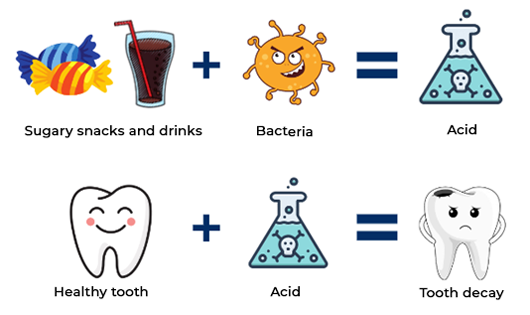On This Page
- Empower your smile! Take care of your teeth
- Brushing and flossing technique
- Oral health in Children
- Oral health in Adults
- Oral health and Pregnancy
- Oral health in Older Adults
- Fluoride FAQ
- Videos How to brush and How to floss
Empowering Smiles, Enhancing Lives
At Tompkins County Whole Health, we believe in the power of a healthy smile. Our mission is to improve your health by providing you with oral health tips, resources, and information about dental care providers and dental insurance options. Your smile matters, and we are here to support you every step of the way.
Why taking care of your teeth matters
Oral health is an important part of whole health, which affects our ability to speak, eat, smile, taste, chew, and swallow. In addition to causing cavities and gum diseases, poor oral hygiene is linked to diabetes, lung and heart diseases, stroke, and other chronic diseases. Maintaining good oral hygiene is essential for fighting oral and systemic diseases.
Brushing and flossing technique
Tooth brushing helps to
- Clean your teeth and tongue of food remnants, debris, and stains.
- Massage and clean the gums.
Brush your teeth twice a day
The American Dental Association recommends brushing your teeth twice a day with a toothpaste that contains fluoride for about two minutes to keep your mouth and teeth healthy. Following the right tooth brushing technique is essential to keep germs away.
Brushing technique
- Place the toothbrush at a 45-degree angle to the gums. It should contact both the gums and tooth surfaces.
- Brush 2-3 groups of teeth gently using back and forth short strokes and then over the chewing surfaces of teeth in a single motion.
- Continue with the next 2-3 groups of teeth.
- Use the same brushing technique to clean both the inner and outer surfaces of each tooth.
Floss daily
Food particles can be found on tooth surfaces as well as in between teeth. Dental floss must be used to remove these particles from in between the teeth.
Flossing technique
- Wrap an 18-inch-long floss string around the middle fingers of each hand.
- Hold about an inch of floss between your thumb and four fingers.
- Gently insert the floss between the teeth until it reaches the gum line while holding it between the thumb and index finger of each hand. Do not force the floss as it could break and harm the gums.
- Slide the floss up and down from the gumline to the chewing surfaces of teeth while maintaining contact with the side of the tooth.
- Repeat this for every side of each tooth and be sure to floss between all the teeth, including the back teeth.
Watch How To videos here.
Oral Health in Children
In the United States, the most common childhood disease is tooth decay. Here are some tips to maintain your child’s oral health.
Regular dental visits
Begin dental visits for your children by the age of 1. Children should visit their dentist once every six months to get their teeth checked and cleaned. Regular dental visits will help detect dental diseases sooner and prevent them.
Avoid sugary snacks and drinks
It is important to limit the intake of sugar in snacks and drinks. Frequent consumption of sugar will lead to tooth decay. Sugar in the foods we consume interacts with bacteria to form acids in your mouth. Acids that are formed break the tooth structure down to form cavities.
Children and teens should consume less than 25 grams of added sugar per day. Children under the age of two should not consume any added sugar in their drinks or meals.

Oral Health in Adults
Oral health is important for an adults’ overall health and well-being. In addition to untreated decay, adults are also prone to gum diseases, and oral cancer.
Tooth decay
More than 1 in 4 adults in the United States have untreated decay. Signs and symptoms of untreated tooth decay include:
- Brown/back spots on teeth
- Toothache
- Holes in the teeth
- Pain during chewing, eating, and drinking cold, hot, or sweet.
- Tooth sensitivity
Gum diseases
In the US, nearly half (46%) of individuals aged 30 years or older, show signs and symptoms of gum diseases. Signs and symptoms of gum diseases include:
- Swollen and painful gums
- Bleeding gums while eating or brushing
- Sensitive teeth
- Bad breath
Oral Cancer
Every year, more than 800 people living in New York have oral and throat cancer. Most oral cancers are painless and are detected only during regular dental examinations. Signs and symptoms of oral cancer include:
- White and red patches in the mouth.
- Swelling in the mouth, jaw, and neck.
- Having trouble eating and drinking.
Avoid tobacco!
Smoking/chewing tobacco increases the risk for gum diseases, decayed tooth, tooth loss, and oral cancer. People who smoke and chew are three times more likely to lose all their teeth than those who do not use tobacco.
Oral Health and Pregnancy
Dental care is important and safe at any stage of pregnancy.
- Pregnancy makes women more prone to gum diseases and dental decay. Around 60-75% of pregnant women have gum diseases where gums become red and swollen.
- Pregnant people are also at a risk for dental decay due to a change in eating patterns. One in four pregnant women have untreated cavities.
- The oral health of a mother strongly predicts the oral health of her children. Children of mothers with high rates of untreated dental decay are three times more likely to experience dental decay as children.
Oral Health in Older Adults
Oral health diseases in older adults include dry mouth, tooth decay, gum diseases, tooth loss, and oral cancer.
- Tooth loss is a very common dental problem in older adults.
- In the United States, nearly all adults aged 65 years and older have had 1 cavity, and about 2 in 3 older adults have gum diseases.
Tips to maintain good oral health in older adults
- Brush after every meal or at least twice a day with fluoridated toothpaste.
- Floss at least once each day.
- Regular oral examination is important for early detection of any cancer lesions.
- Keep your dentures clean and well fit.
- Avoid tobacco
- Limit alcohol
- Visit your doctor if you have dry mouth due to any medications.
Fluoride FAQ
What is fluoride?
Fluoride is a naturally occurring mineral found in soil, water, and food.
| Foods that contain fluoride | (mg/serving) |
| Brewed black tea | 0.07-1.5 |
| Brewed coffee | 0.22 |
| Canned shrimp | 0.17 |
| Raisins | 0.08 |
| Cooked oatmeal | 0.08 |
| Grapefruit juice | 0.08 |
| Baked potatoes russet | 0.08 |
| Cooked rice | 0.04 |
What are the benefits of fluoride?
Fluoride forms a protective layer on tooth surface and strengthens the tooth structure, making it more resistant to tooth decay. Fluorides reduce tooth decay by 40% in children and adults. That's why fluorides are added to most toothpastes, varnish, gels, and foams.
What is fluoridated water?
Fluoridated water is an evidence-based public health prevention method in which fluoride is added to water to a level that is beneficial for dental health. About 72% of New York state residents have fluoridated water in their community water systems.
Drinking fluoridated water bathes the tooth surfaces with low levels of fluorides throughout the day, making the tooth more resistant to tooth decay. Children living in areas with fluoridated water have 2 fewer decayed teeth compared to those children living in non-fluoridated communities.
Tompkins County is one of the nine out of New York's 62 counties with no community fluoridated water.
Is Fluoridated water safe for me and my children to drink?
Yes. Decades of research have found that fluoridated water at a concentration of 0.7mg/L is safe for drinking.
Are there health risks associated with fluoride?
No. There is no scientific evidence that proves the association of fluorides with any illness or diseases, specifically with a fluoride concentration of 0.7mg/L in water.
When we brush our teeth with fluoride toothpaste every day, do we still benefit from fluoridated water?
Yes. This works better than toothpaste alone to prevent tooth decay.
Find a Dentist Near You
Use our map to locate dental healthcare providers in Tompkins County. Click on the pins to view details including the doctor's name, address, and contact information.
Dental Insurance Guide
Navigating dental insurance options can be overwhelming. Learn about how dental insurance works and explore the types of coverage available in this Dental Health Insurance Guide.
You can also call the Tompkins County Help Line. Dial 2-1-1 for assistance with dental insurance.
Videos
from mouthhealthy.org

